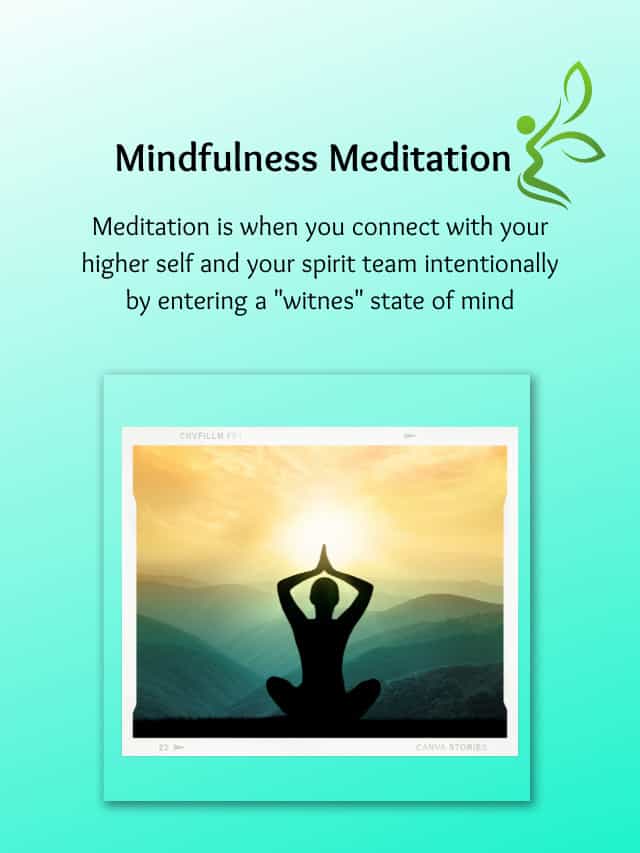Mindfulness Meditation is a spiritual practice that many people choose to follow, but some feel it is too time-demanding. Before committing to this activity, take the time to learn the difference between the two.
Mindfulness is a practice, and it can take many forms. Some people refer to mindfulness as being mindful of yourself; others choose to focus on their thoughts and feelings from a distance without judgment. The goal of the practice is always the same: observe your thoughts and feelings from a distance without judgment.
Meditation is an ancient eastern practice (practised in India for centuries) that involves sitting during work hours and achieving a state of inner enlightenment. In today’s hectic schedule, it’s not always easy to find time for meditation, but there are many ways to incorporate meditation into your day-to-day life.
So, we can say that Mindfulness differs from meditation because it focuses more on the present moment. It doesn’t involve any specific activities like mediation often does. In contrast, meditation can achieve inner peace and balance in life.
What is Mindfulness Meditation?
Mindfulness meditation is a form of therapy that helps you to focus on the present moment. It is achieved by focusing on your breathing and being aware of the thoughts passing through your mind without judging them.
Clinical settings have recommended meditation to help people with anxiety and depression. Mindfulness Meditation helps users become more mindful, which creates a sense of calmness within the body. It helps in reducing stress, improving concentration, and boosting self-esteem.
One can practice meditation anywhere, and it doesn’t take much effort. All you need to do is sit comfortably, close your eyes, focus on breathing, and let thoughts pass by without judging them.
5 Powerful Steps to Practice Mindfulness Meditation
Step 1: Find the Perfect Place to Practice Your Meditation
Meditation can be a difficult task to do at home. We are constantly bombarded with noise and distractions. However, there are some ways to make it easier.
- Find a quiet place in your home where you can practice meditation without being interrupted by noise or other people. Doing this helps you to focus on the task at hand and not get distracted by other things that may be going on in your home or outside of it.
- You can also try meditating outside of your home, like in a park or somewhere else that is quiet.
- If you have trouble sitting still for long periods, try meditating while walking around instead of sitting down.
- Create a routine for when you meditate so that it becomes more ingrained in your daily life and less of an afterthought when you think about doing it.
- Listening to music can also help to ground you and focus your mind.
Step 2: Set the Right Environment for Yourself
Meditation is a great way to reduce stress and improve focus, so you must set yourself up for success. Some people prefer to meditate with music, and some without. The best way to find out what works for you is to try different things and see what feels best.
Different Types of Mindfulness Meditation
Music Meditation:
This meditation is ideal for people who meditate while listening to or want to meditate with music. You must choose a peaceful track or one that makes your body feel good if you’re going to use the psychedelic track.
Unplugged Meditation:
This is typically done without any sound at all. You’ll need to find a quiet place or close your eyes, focus on your breath, and pay attention to the feeling of your body. Unplugged meditation can help with stress, anxiety, and other physical ailments such as headaches or chronic pain.

Drowning Out The World:
This meditation has been described as “a bridge between detachment and intimacy by entering a state in which you let go of everything but the present moment.” To do this, you’re going to focus on your breath ( or your heartbeat) and try to forget everything else.

Breath Awareness Meditation:
This meditation is a mindfulness technique which helps to cultivate the ability to be aware of one’s breath and body. This technique can be used with any other meditation or standalone practice. Breath Awareness Meditation is one of the most famous Buddhist meditation techniques today because it is proven effective in reducing stress and anxiety levels and improving sleep quality and duration.

Step 3: Choose the Right Material For your Practice
Let’s look at the three most popular meditation apps: guided meditation app, best meditation podcast and a meditation app for beginners.
Guided Meditation Apps:
A guided meditation app is an application that offers a series of guided meditations. These apps are perfect for those who want to take their practice to the next level as they provide instructions on breathing and what to visualize. They also offer audio instructions on how you should be feeling during each part of the session.
Best Meditation Podcasts:
The best meditation podcast is an audio recording or a video recording that offers tips and advice on how to meditate. This media type is perfect for those looking for a more hands-off approach as it only requires you to listen or watch.
Meditation App For Beginners:
A beginner’s meditation app is an application that offers simple instructions on how to meditate. This app would provide pre-written scripts and guided meditation sessions that are meant to be read.
Meditation App For Kids: A meditation app for kids is a mobile application that provides guided meditations and activities to help children learn how to meditate. This app is also an extension of the mindfulness movement, which helps young people learn self-regulation skills while playing games or reading stories.
Step 4: Choose Your Ideal Position
Finding the correct position for your body is the key to healthy and productive work life. This position will allow you to work at your best and give you the most energy.
Several factors will help you determine which position suits you best. These include:
– Your height, weight, and arm length
– Your type of job
– Your level of comfort
– Your back or neck issues
– The chair or cushion you use
Step 5: Start Your Practice and Enjoy Every Moment of it!
Last but not least, the fifth step is to start practising! You have researched, found a reputable coach, and are ready to make it happen. The good thing is that there are many ways to practice – in the car, at work, with friends. After you find your groove, it can be hard to stop.
This step is about finding a way that works for you and start your practice! Your work is now complete, and it’s time to start practising!
The Science Behind the Benefits of Meditation on Your Brain and Happiness
The science behind the benefits of meditation on your brain and happiness is still being researched. But many experts in the field have concluded that meditation can be beneficial in many ways.
Meditation has many health benefits, but one of the best in stress relief. Studies have shown that people who meditate regularly have lower levels of cortisol. This hormone increases during stress and anxiety, which means that people who meditate are less likely to experience depression, anxiety, or other mental health problems.
Meditation has proven to be beneficial for sleeping well. Regular practice can help you fall asleep faster and sleep longer than those who don’t regularly practice. You may want to opt for yoga, meditation or other forms of mindfulness combined with exercise as a healthier alternative to conventional sleep strategies. All these techniques help you to feel more of a positive effect at work or school so that they can improve your quality of life.
Conclusion: Why You Need To Start Practicing Mindfulness Meditation Today
Mindfulness meditation has been shown to help people live longer, have healthier hearts, lower blood pressure, and even lower the risk of depression – all in just 8 weeks!
In conclusion, mindfulness meditation is an opportunity for those who want to start living a more mindful life. Mindfulness meditation techniques have improved several physical and mental health aspects, including clarity, stress levels, and more. Mindfulness meditation has no downside, and you can start today with the benefits of daily mindfulness. You’ll need to participate in the practice of meditation for an extended period, so you should commit yourself for now.



3 thoughts on “5 Powerful Steps to Practice Mindfulness Meditation”